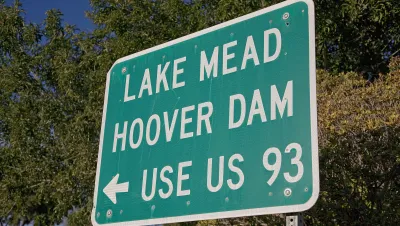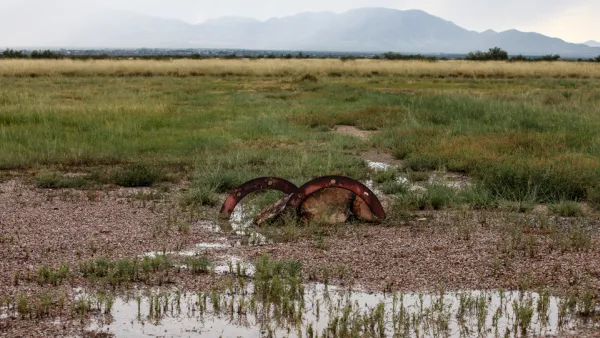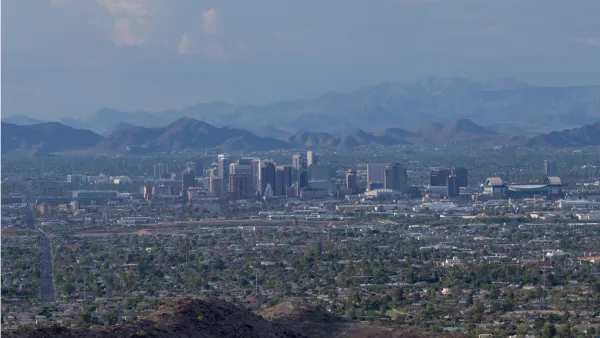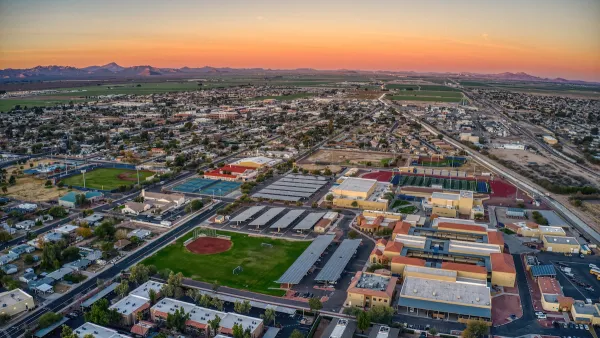As more and more people move to the suburbs blossoming in the Phoenix metro area, local water officials are increasingly concerned about the region's ability to keep up with demand.

Since before the pandemic, Phoenix has seen explosive growth as people seek out its affordable housing, warm climate, and work opportunities. But as Sarah Tory reports in High Country News, "[t]he region doesn’t appear to have enough water for all the planned growth."
Despite the looming threat of a dwindling water supply in the American Southwest, "people keep moving here — to the hottest, driest part of the country," Tory writes. The population of the Phoenix area is expected to grow to more than 7 million by 2040, with author and sociologist Andrew Ross calling it the "least sustainable city on earth." In addition to a small amount of groundwater and treated wastewater, "[m]ost of the valley’s water supply comes from the winter snowpack in distant mountains, which melts and flows through a vast system of dams, reservoirs and canals."
"A 2019 report published by the Kyl Center warns that in the long term there likely won’t be enough surface water available from the Central Arizona Project to replenish the groundwater used by all the homes currently planned for the Phoenix suburbs." The ambitious growth plans of many local cities pose serious questions about where future water supplies will come from. "Next year, water levels on Lake Mead, the largest reservoir on the Colorado River, are projected to drop to their lowest levels yet, triggering the first-ever official shortage declaration by the federal government. The declaration will cut Arizona’s Colorado River supplies by a fifth." As Tom Buschatzke, director of the Arizona Department of Water Resources put it, "[w]e’ll have to make some hard decisions."
FULL STORY: Rapid growth in Arizona’s suburbs bets against an uncertain water supply

National Parks Layoffs Will Cause Communities to Lose Billions
Thousands of essential park workers were laid off this week, just before the busy spring break season.

Retro-silient?: America’s First “Eco-burb,” The Woodlands Turns 50
A master-planned community north of Houston offers lessons on green infrastructure and resilient design, but falls short of its founder’s lofty affordability and walkability goals.

Delivering for America Plan Will Downgrade Mail Service in at Least 49.5 Percent of Zip Codes
Republican and Democrat lawmakers criticize the plan for its disproportionate negative impact on rural communities.

Test News Post 1
This is a summary

Test News Headline 46
Test for the image on the front page.

Balancing Bombs and Butterflies: How the National Guard Protects a Rare Species
The National Guard at Fort Indiantown Gap uses GIS technology and land management strategies to balance military training with conservation efforts, ensuring the survival of the rare eastern regal fritillary butterfly.
Urban Design for Planners 1: Software Tools
This six-course series explores essential urban design concepts using open source software and equips planners with the tools they need to participate fully in the urban design process.
Planning for Universal Design
Learn the tools for implementing Universal Design in planning regulations.
EMC Planning Group, Inc.
Planetizen
Planetizen
Mpact (formerly Rail~Volution)
Great Falls Development Authority, Inc.
HUDs Office of Policy Development and Research
NYU Wagner Graduate School of Public Service





























